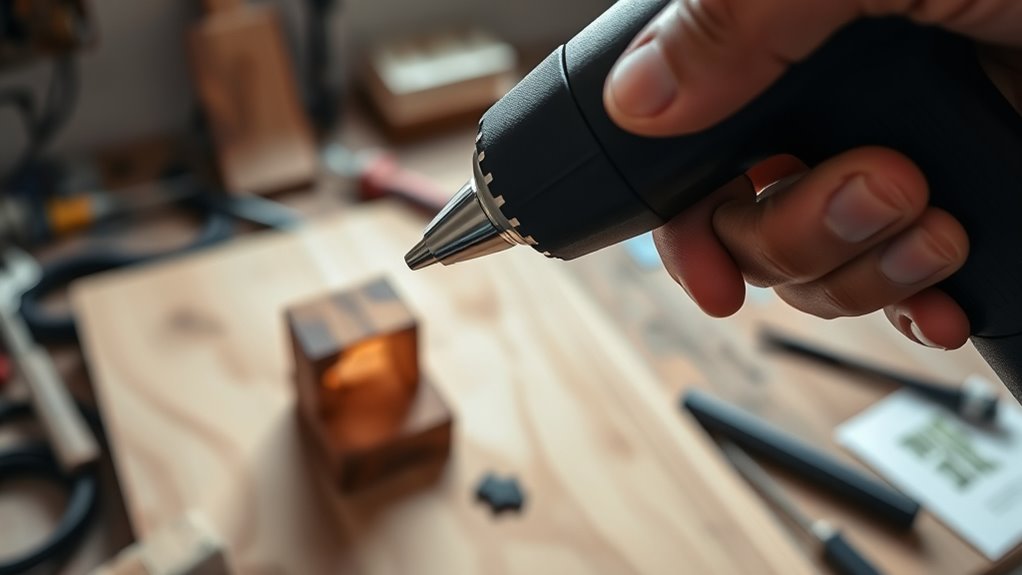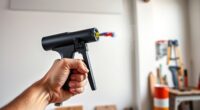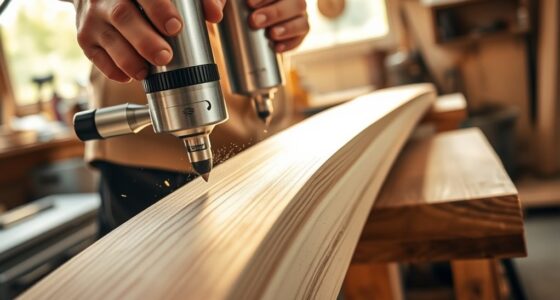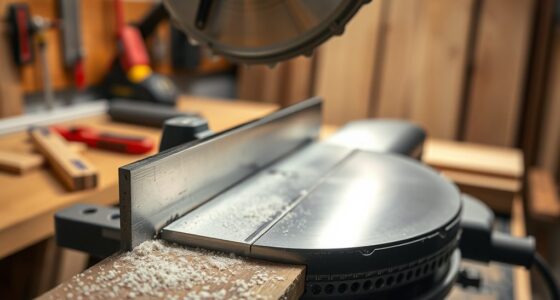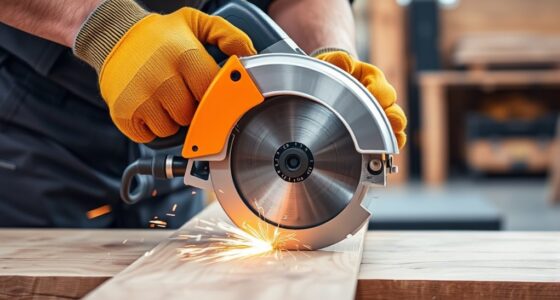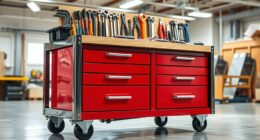To use a heat gun for DIY projects, start by inspecting it for damage and selecting the right nozzle. Set the temperature low to test your material, then hold the tool steady and keep it moving to avoid damage or overheating. Keep the heat gun at a safe distance from your work and avoid pointing it at yourself. Always wear protective gear, work in ventilation, and once finished, turn it off and allow it to cool. If you continue exploring, you’ll discover detailed safety tips and effective techniques.
Key Takeaways
- Inspect the heat gun for damage and ensure safety features are functioning before use.
- Choose the appropriate nozzle and set the temperature suitable for your DIY project.
- Hold the heat gun at a safe distance and keep it moving steadily to prevent material damage.
- Use protective gear like gloves and safety glasses to avoid burns and injuries.
- Turn off, unplug, and allow the heat gun to cool completely before storing or changing accessories.
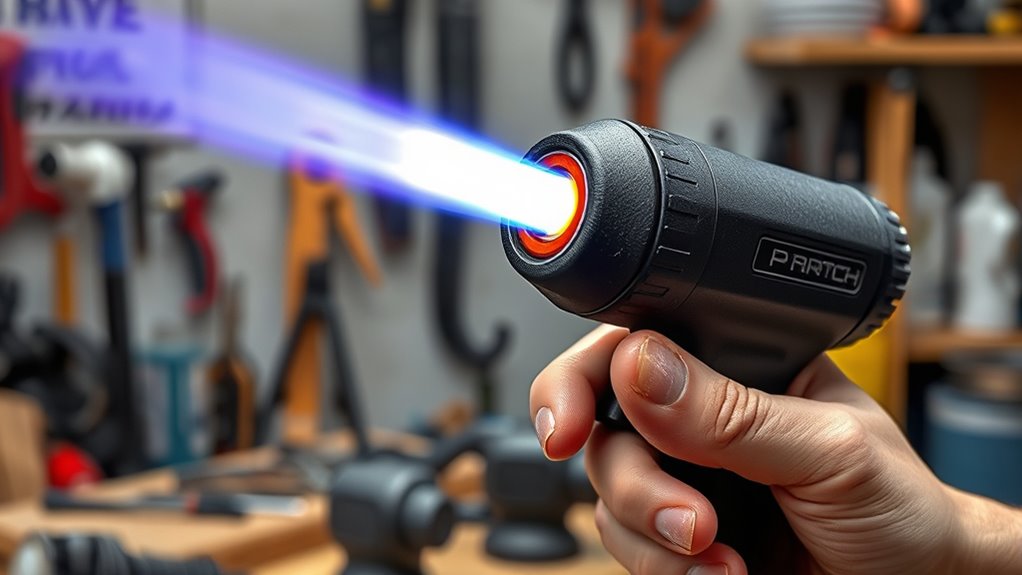
A heat gun is a versatile tool that can make tasks like stripping paint, thawing frozen pipes, and shrinking tubing much easier. However, before you embark on using it, you need to prioritize safety precautions. Heat guns emit intense, focused heat, which can cause burns or fires if not handled carefully. Always wear protective gear such as gloves, safety glasses, and a long-sleeved shirt to shield your skin and eyes. Work in a well-ventilated area to prevent inhaling fumes from heated materials, especially when stripping paint or plastics that can release harmful chemicals. Keep a fire extinguisher nearby as a precaution, and never point the heat gun at yourself or others. Avoid using it near flammable substances or in damp conditions, which increase the risk of accidents. Also, be cautious about the heat gun’s cord; make sure it’s out of your way to prevent tripping or accidental unplugging during use.
Proper tool maintenance is equally important to guarantee safe and effective operation. Before plugging in your heat gun, inspect it for any damage to the cord, plug, or body. Damaged tools can malfunction or pose electrical hazards, so replace or repair them before use. Keep the nozzle clean and free of debris, which can affect heat distribution and cause uneven heating. After each use, let the heat gun cool down completely before storing it away. Regularly check the air filters (if your model has them) and clean or replace them as needed. Proper maintenance not only extends the life of your tool but also helps prevent accidents caused by malfunctioning equipment. Additionally, understanding the proper application techniques can enhance your safety and efficiency when working with heat guns.
When you start using the heat gun, always begin at the lowest temperature setting to gauge how the material responds. Hold the tool steady and keep it moving to avoid concentrating heat in one spot, which can cause scorching or damage. Use a proper nozzle attachment for specific tasks—narrow nozzles for detailed work, wide nozzles for larger surfaces—to improve control and safety. Remember that heat can transfer quickly, so always keep a safe distance from the work surface and avoid prolonged exposure to prevent overheating or unintended damage. After finishing your project, turn off and unplug the heat gun, allowing it to cool in a safe place. Proper safety precautions and diligent tool maintenance help you work efficiently while minimizing risks, making your DIY projects safer and more successful.
Frequently Asked Questions
Can I Use a Heat Gun for Plastic Welding?
Yes, you can use a heat gun for plastic welding. It works well with heat gun techniques that involve directing controlled, even heat to fuse plastic pieces together. Make sure to set the right temperature and keep the gun moving to avoid burning the material. Practice on scrap plastic first to get comfortable with the process, ensuring a strong, seamless weld without damaging your project.
What Safety Gear Is Essential When Operating a Heat Gun?
When operating a heat gun, safety gear is essential. You should wear protective gloves to shield your skin from burns and a respirator mask to avoid inhaling fumes or dust. Always work in a well-ventilated area and keep a safe distance from the heat stream. These precautions help prevent injuries and make sure safe, effective use of your heat gun during DIY projects.
How Do I Prevent Overheating Surfaces With a Heat Gun?
Think of your heat gun as a gentle breeze, not a wildfire. To prevent overheating surfaces, focus on temperature control by keeping the gun moving constantly and avoiding prolonged contact. Protect surfaces with heat-resistant tape or shields, like a shield guarding a treasure. This way, you guarantee even heating and avoid damage, making your project safer and more successful. Always monitor your work to keep surfaces cool and intact.
What Are the Best Heat Settings for Different Materials?
When choosing the best heat settings, consider temperature calibration and material compatibility. For delicate materials like plastic or vinyl, use a lower setting, around 200-300°F, to prevent damage. For thicker surfaces like wood or metal, increase the temperature gradually, up to 1,000°F if needed. Always test on a small area first to make sure the heat won’t cause warping or burning, adjusting the settings accordingly.
Can a Heat Gun Remove Old Paint Safely Indoors?
Yes, you can use a heat gun for paint removal indoors safely if you follow proper precautions. Keep the heat gun at a safe distance and use a low to medium heat setting to avoid scorching the surface or creating fumes. Make certain good indoor safety by working in a well-ventilated area, wearing protective gear, and keeping a fire extinguisher nearby. Always read manufacturer instructions before starting.
Conclusion
Now that you know how to wield a heat gun like a pro, remember the wise words of Da Vinci: “Simplicity is the ultimate sophistication.” With patience and proper technique, you’ll transform your DIY projects effortlessly, just as an artist brings a masterpiece to life. Keep safety in mind, stay confident, and let your creativity run wild. Before long, you’ll be creating with the precision and finesse of a true master, making every project a work of art.
